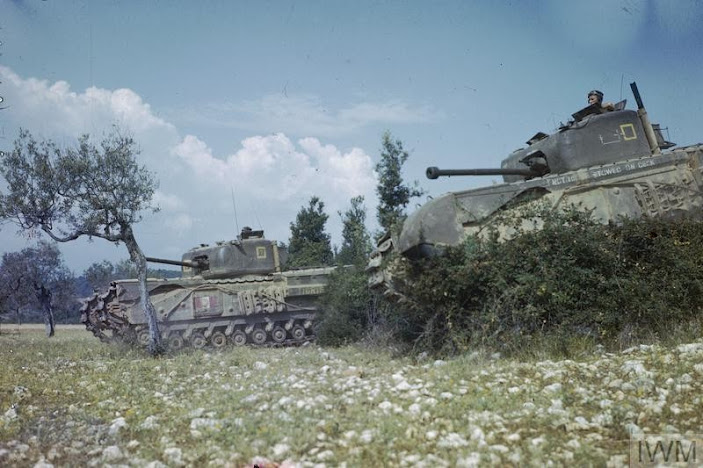These PSC M5 half tracks where bought for the big Market Garden weekend in 2018 (see a paint job to far). I have too many for my small NW Europe Irish Guards. So these I have found a use for in my main period - Italy and Tunisia in 1943. The main use for the lend-lease half track in this theatre was in Royal Artillery particularly Anti-tank battalions. I will use these in Tunisia and Italy in 1943-1944 as tows for 17 pounder and 6 pounder anti tank guns as well as forward observers and resupply vehicles and, eventually, as a ride for my Royal Engineers.
This anthe M5 towing my 17/25 pounder Pheasant. I added the canvas tilts using PVA soaked tissue and brass rod.
Deployed 17/25 pounder with AB crew
Really enjoyed painting these as First Army crew
Crew from a different angle
Clse up of the 6 pounder gun battery on the move
A good view of the tilts cheap to do and quick I really like the effect/ The guns are the early version of the six pounder without muzzle suppressor from Grubby.
The six pounder deployed with AB crew for this crew the NW Europe but painted to look a little more mediterranean.
Loader team for Battlegroup using spare figures from the six and seventeen pounder crew Camouflage in desert pink and green
The six pounder has the AB western desert crew - more of an Eigth Army feel!
The Western Desert AB miniatures loader team for Battlegroup These loader teams will get heavy use also be useful with my twenty-five pounder artillery battery
Deatail of the crew in this ruined Tunisia building
My Antitank battery takes on three Early War Miniatures Panzer III's,
Let see how Column Bari like a wall of six pounders between them and Medenine. See my campaign reports and ARR for our Battle of Medenine campaign.
The two pounder deployed
AB crew and toothbrouch thorn bush.
With the wheels on for towing.
This anthe M5 towing my 17/25 pounder Pheasant. I added the canvas tilts using PVA soaked tissue and brass rod.
Deployed 17/25 pounder with AB crew
Really enjoyed painting these as First Army crew
Crew from a different angle
Clse up of the 6 pounder gun battery on the move
A good view of the tilts cheap to do and quick I really like the effect/ The guns are the early version of the six pounder without muzzle suppressor from Grubby.
The six pounder deployed with AB crew for this crew the NW Europe but painted to look a little more mediterranean.
Loader team for Battlegroup using spare figures from the six and seventeen pounder crew Camouflage in desert pink and green
The six pounder has the AB western desert crew - more of an Eigth Army feel!
The Western Desert AB miniatures loader team for Battlegroup These loader teams will get heavy use also be useful with my twenty-five pounder artillery battery
Deatail of the crew in this ruined Tunisia building
My Antitank battery takes on three Early War Miniatures Panzer III's,
Let see how Column Bari like a wall of six pounders between them and Medenine. See my campaign reports and ARR for our Battle of Medenine campaign.
The two pounder deployed
AB crew and toothbrouch thorn bush.
With the wheels on for towing.























Comments
Post a Comment